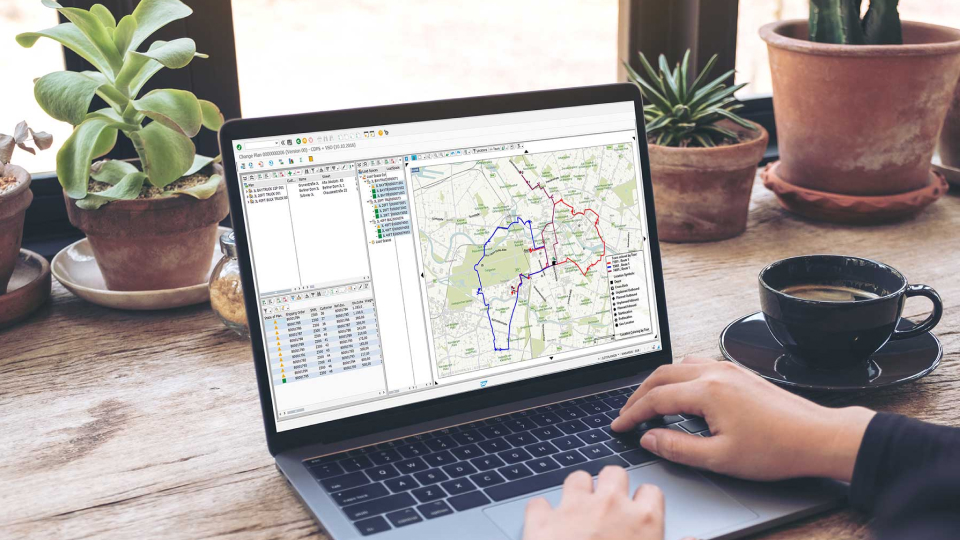
School Bus Transportation Software : 10 Features to Look for
In today’s fast-paced world, ensuring safe, efficient, and reliable school transportation is a top priority for educational institutions. With increasing student populations and complex routes, managing school bus operations can be challenging. School bus transportation software has become a game-changer. It offers innovative solutions to streamline operations, enhance safety, and improve communication. This software enables real-time tracking, route optimization, and data-driven decision-making, helping school districts and transportation managers stay on top of their game.

You might be thinking “what are the basic features that I should look for in school bus routing software?”
In this blog, we will explore the top 10 features to look for in school bus fleet management software. These features not only improve the overall efficiency of the system but also ensure that students are transported safely and on time. Whether you’re considering an upgrade or a new system, understanding these key features will help you make the right choice.
Benefits of School Bus Transportation System
The benefits of a school bus transportation system are numerous and impactful, both for school districts and the families they serve. Here are some key advantages:

1. Safety
School buses are one of the safest modes of transportation for students. They are equipped with safety features like seat belts, flashing lights, and stop signs to protect children while traveling to and from school.
2. Cost-Effective
A well-managed school bus system can help reduce transportation costs by consolidating the number of vehicles needed, and saving on fuel, maintenance, and staffing.
3. Environmentally Friendly
School buses can be more eco-friendly compared to individual car commutes. By reducing the number of cars on the road, school buses help cut down on emissions, making the commute greener.
4. Improved Attendance
Reliable transportation ensures that students arrive at school on time, leading to improved attendance rates and better academic performance.
5. Convenience
School buses offer a convenient option for families, especially those who live far from the school or in areas without reliable public transportation.
6. Reduced Traffic Congestion
By providing a dedicated transportation option, school buses help reduce congestion near schools, leading to safer and less stressful school drop-off and pick-up times.

7. Social Interaction
School buses provide students with an opportunity to interact with their peers outside of the classroom, fostering a sense of community and belonging.
8. Time Efficiency
With pre-determined routes, school buses ensure that students are picked up and dropped off efficiently, saving time compared to individual car rides.
9. Accountability and Monitoring
A well-managed school bus system, especially one with GPS tracking and monitoring, helps keep track of student attendance, driver behavior, and bus route efficiency, ensuring higher levels of accountability.
10. Emergency Preparedness
In case of an emergency, school buses are equipped with communication systems, helping to quickly notify parents and authorities and ensuring timely responses.
10 Must-have Features of School Bus Management Software
1. Real-Time GPS Tracking
Real-time GPS tracking is one of the most essential features of school bus tracking software. It allows school administrators, parents, and transport managers to track the exact location of buses throughout the day. This feature ensures that buses follow their designated routes, reducing delays and improving on-time performance. For parents, it provides peace of mind, as they can receive real-time updates on bus arrivals or delays, allowing them to adjust their schedules accordingly.
Additionally, GPS tracking enables quick responses to unforeseen situations, like traffic or road closures, by providing alternative route suggestions. School districts, it help monitor bus utilization and improve overall fleet management by tracking route efficiency. In emergencies, GPS tracking also assists in locating buses quickly, ensuring student safety and swift action if needed.

2. Route Optimization
Route optimization is a key feature that ensures school buses take the most efficient paths, saving time, fuel, and reducing wear on the vehicles. By analyzing real-time traffic data, weather conditions, and student pick-up/drop-off locations, the software can dynamically adjust routes to avoid congestion or delays. This helps buses stay on schedule, reducing the chances of tardiness.
Route optimization not only enhances efficiency but also contributes to safety by ensuring buses are not idling for long periods, minimizing the risk of accidents. Moreover, it can be used to plan the most eco-friendly routes, decreasing fuel consumption and the school district’s carbon footprint. This feature also allows transportation managers to make data-driven decisions for long-term improvements in route planning, further improving operational costs and effectiveness. Ultimately, route optimization ensures that students are picked up and dropped off in a timely, safe, and cost-effective manner.

3. Parent and School Communication Integration
Effective communication between parents, schools, and transportation managers is crucial for ensuring student safety and keeping everyone informed. School bus transportation software with integrated communication features provides real-time updates on bus arrivals, delays, and any changes in routes.
Parents can receive notifications via mobile apps, text messages, or emails, allowing them to track their child’s bus and plan accordingly. In case of emergencies or unexpected delays, schools can quickly notify parents, keeping them in the loop. Additionally, the software can enable two-way communication, allowing parents to ask questions or report concerns directly to the school or transport team. This feature fosters trust and transparency, helping to prevent miscommunication and reducing anxiety for parents. By streamlining communication, both schools and parents can ensure a more organized and responsive transportation system for students.

4. Student Safety Features
Student safety is the top priority in school bus transportation, and software solutions offer several features to ensure a secure journey for every student. One key feature is the student check-in/check-out system, where students are logged as they board and exit the bus. This ensures that every child is accounted for at all times. Some systems also include features like geofencing, which sends alerts when a bus deviates from its planned route or enters restricted areas.
Additionally, many school bus tracking software solutions offer emergency alert systems that notify parents, schools, and bus drivers instantly in case of unexpected situations. Some even include cameras or monitoring systems to provide real-time surveillance on the bus, ensuring proper behavior and quick response in case of emergencies. These safety features help prevent unauthorized access, ensure accountability, and give parents peace of mind that their children are always protected.
5. Fleet Management Tools
Fleet management tools in school bus fleet management software are essential for maintaining a smooth and efficient operation. These tools help administrators keep track of vehicle maintenance schedules, ensuring that buses are regularly serviced to prevent breakdowns. By tracking mileage, engine performance, and service history, the software can send automated reminders for upcoming maintenance tasks like oil changes or tire checks, reducing unexpected repairs and extending the lifespan of the vehicles.
Additionally, fleet management tools allow for fuel tracking, helping to monitor fuel consumption and optimize routes for cost savings. These tools also provide insights into driver performance, such as speed and idling times, helping to improve driving habits and reduce fuel wastage. By offering a comprehensive view of fleet operations, these tools help improve safety, reduce operational costs, and increase overall efficiency, ensuring that buses are always ready and reliable for daily routes.

6. Scheduling and Timetable Management
Scheduling and timetable management are very important aspects of bus transportation for schools. School bus tracking software helps create and maintain accurate, up-to-date bus schedules that align with school hours, extracurricular activities, and special events. It enables flexible adjustments in real-time for unexpected changes such as weather conditions, school delays, or student absences.
This feature ensures that buses arrive on time for pick-ups and drop-offs, minimizing disruptions and maximizing the use of resources. Additionally, the software can automatically handle recurring schedule adjustments, such as holiday breaks or half-days, saving time for administrators. By offering a streamlined approach to scheduling, the software reduces human error and helps transportation managers easily communicate changes with drivers, schools, and parents. Ultimately, this ensures a smooth and efficient transport system that aligns with students’ needs and school requirements.
7. Driver Management and Monitoring
Driver management and monitoring features in school bus management software play a critical role in maintaining safety and operational efficiency. These tools allow administrators to track driver behavior in real-time, such as speed, braking patterns, and idle times, ensuring compliance with safety regulations. By monitoring these metrics, schools can identify areas for improvement, encourage safe driving habits, and provide necessary training or interventions.
The software also allows for driver scheduling and assignment, ensuring that the right driver is assigned to the appropriate route based on availability and qualifications. Additionally, many systems include features for tracking driver certifications, training records, and performance reviews, ensuring that drivers meet all necessary standards. This comprehensive management system not only helps improve safety but also enhances accountability, reducing the risk of accidents and ensuring that students are transported by qualified, responsible drivers.

8. Mobile App Accessibility
Mobile app accessibility is a key feature of modern school bus transportation software, enhancing convenience for both parents and drivers. For parents, the mobile app provides real-time updates on bus locations, expected arrival times, and any delays. Parents can track the bus and receive notifications directly on their smartphones, helping them plan their schedules accordingly and ensuring their children are safely picked up and dropped off. For drivers, the mobile app offers an easy-to-use platform for managing routes, receiving updates, and reporting issues or delays in real time.
It also enables communication with transportation managers, ensuring seamless coordination throughout the day. Additionally, the app can provide access to important safety features, such as emergency alerts or incident reporting. By offering mobile app accessibility, schools and transportation managers ensure that all stakeholders can stay informed and connected, improving overall efficiency and safety in the transportation system.
9. Data Analytics and Reporting
Data analytics and reporting are powerful features in school bus transportation systems that provide actionable insights to improve operations. The software collects and analyzes data from various sources, such as bus routes, fuel usage, maintenance records, and driver performance. This allows transportation managers to identify trends, inefficiencies, and areas for improvement.
Detailed reports can be generated on aspects like route performance, cost per mile, and on-time performance, helping school districts make data-driven decisions for optimizing their fleet and resources. For example, by analyzing fuel consumption and route efficiency, transportation managers can make adjustments to reduce costs and improve environmental sustainability.
Additionally, performance data on drivers and buses allows for better planning of training programs, vehicle maintenance, and fleet expansion. Data analytics and reporting ultimately empower decision-makers to enhance safety, reduce costs, and improve overall service quality, making school transportation operations more effective and sustainable.

10. Compliance with Local Regulations
Compliance with local regulations is a critical feature of school bus fleet management software, ensuring that all operations adhere to safety, environmental, and legal standards. The software helps schools stay up-to-date with local and state regulations, such as vehicle inspection requirements, driver certifications, and student safety protocols. It can automate reminders for vehicle inspections, license renewals, and compliance checks, reducing the risk of missed deadlines and penalties.
Additionally, the software can track and store documentation related to driver qualifications, background checks, and training, ensuring that all staff meet required legal standards. By providing features that ensure regulatory compliance, the software minimizes the risk of legal issues and fines. It also helps schools maintain a transparent and accountable system, demonstrating their commitment to safety and legal adherence. Ultimately, compliance features support smooth and responsible operations while safeguarding the well-being of students and staff.
Tap on the Right Bus Transportation for Schools
Choosing the right school bus transportation software with the right features is essential for improving efficiency, safety, and communication within the transportation system. From real-time GPS tracking and route optimization to data analytics and regulatory compliance, these tools ensure smoother operations, reduce costs and enhance student safety.
By investing in the right school bus transportation software, school districts can streamline their transportation processes, keep parents informed, and provide reliable service. Prioritizing these key features will lead to a safer, more efficient, and cost-effective transportation solution for schools and students alike.




